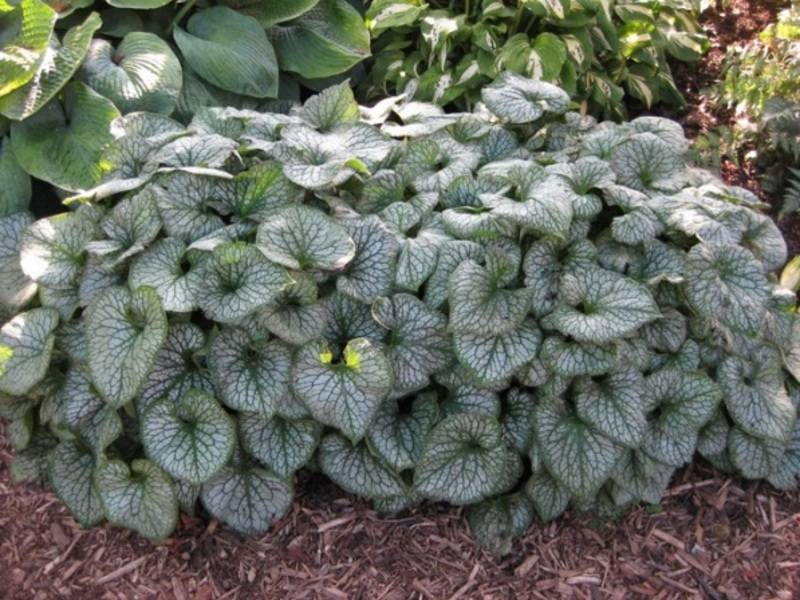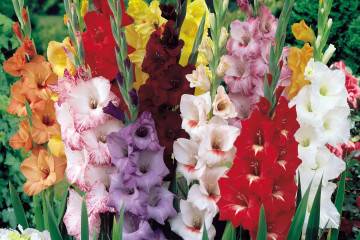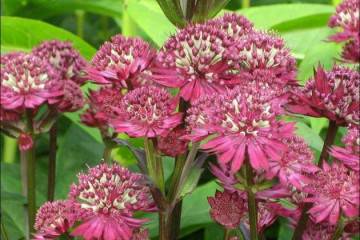Brunner large-leaved
Content:
The sky-blue inflorescences of the brunners in flower beds, appearing in mid-May, are often confused with forget-me-nots. These plants are indeed very similar in configuration and size. Brunner's flower is a perennial herb that thrives in shaded areas, lowlands where groundwater accumulates.
Origin and appearance
The culture is characterized by large wide heart-shaped leaf blades, branched drooping stems and a thick rhizome. The perennial grows in height from 45 to 60 cm. The Caucasus, Siberia and Asia Minor are considered the homeland.
The name of the flower was given by the Swiss botanist S. Brunner. Brunner's flowers with their unusually sky-blue hue attracted his attention at the moment when he traveled across the Crimea.
As a culture of Brunner (in Latin "Brunnera macrophylla") it has been known since 1827. During the existence of the plant, many interesting varieties have been bred, which differ in the shade of flowers and color of the foliage.
Description of the flower
Without a transplant, the plant can grow for about 14-16 years. It is this feature that makes the flower very beneficial for any garden. With proper care, the flower can grow up to 60 cm. It features erect, lowered stems, large and rich green foliage with sharp tips. The leaves are rough to the touch. The flowers are small, sky-blue with a white center, they appear in May-June and are pleasing to the eye for 25 days. At the end of this time, the seeds ripen on the plant.
Varieties and varieties
Currently, there are the following varieties of brunner:
- large-flowered. It is characterized by drooping stems, heart-shaped leaves. Apical flowers are about 7 mm in diameter. The birthplace of culture is the Caucasus;
- Siberian. This plant looks like a forget-me-not, only with large leaves. The flower grows to a height of 60 cm. The foliage is dense with a wrinkled surface. It is located at the root. The flowers are dark blue in diameter, about 5 mm. Brunner Siberian is distinguished by paniculate inflorescences, flowering lasts up to several weeks;
- eastern - undersized brunner, characterized by excellent resistance to negative weather conditions. The leaves are elliptical, it grows up to 10 cm. The flowers look like forget-me-not.
In addition to the fact that Brunners are divided into types, they also come in different varieties.
The most popular varieties are:
- Silver Hut. Green veins, a border on silvery foliage give this variety a unique and mesmerizing appearance. The flower can grow in direct sunlight. It is completely unpretentious to the composition of the soil;
- Variegata. The flowers of the variegated brunner are colored blue, and the leaves are green with a white edging;
- Looking voice. The flowers are blue, the leaves are silvery with olive-silvery veins;
- Kings Ransom. Bushes of the plant are undersized with heart-shaped light gray leaves. The veins on them are dark emerald;
- Jack Frost. Leaves are silvery with a thin green border around the edges. A feature of the variety is that the plant requires mandatory spraying once every two weeks;
- The greatness of Alexander is an attractive plant with a large mop of leaves, the surface of which is densely silvered. The plant reaches a height of 25 cm, and grows in diameter up to 70 cm.
Regardless of the fact that brunners are divided into varieties and types, they all have an attractive appearance and are rightfully considered an adornment of any place.
Landing in open ground
You can meet variegated Brunner in natural conditions in forests. The plant often grows in humid and shaded areas. It is imperative to pay attention to such features when choosing a landing site. Planting takes place from late July to early August.
What is needed for landing
For planting a Brunner-forget-me-not, it is necessary to choose the right soil. For the Siberian species, heavy, wet and clayey soil is more suitable, and for a large-leaved one - loose and fertile soil.
Choosing the best place
In order to provide the shrub with conditions close to natural on the garden plot, it is necessary to choose the right place. Direct sunlight can lead to the death of the plant, so it is best to plant it in the shade or near a pond. It should be borne in mind that excessive shade is also detrimental to the plant, therefore, planting a flower in partial shade is considered the best option.
Since brunner is a moisture-loving plant, this specificity must be taken into account when planting.
Step-by-step planting process
For a flower such as a bruner, planting and care must be carried out correctly. Only in this case will the plant delight with its attractive appearance. Typically, the fit coincides with the separation process. To do this, follow these steps:
- As soon as the bush has completely bloomed, you need to carefully cut off the entire aerial part from it, leaving 10 cm of shoots.
- Then the plant is dug up, the roots are cleared of the earth and washed.
- The bush is divided into several parts.
- The holes for planting are prepared in advance, a young plant is planted in them, sprinkled with soil and watered abundantly with water.
Breeding brunner
Brunner's flower propagates both by seed and vegetative methods. At the same time, it is inappropriate to propagate varietal specimens by seeds. This is explained by the fact that they do not have time to ripen before frost, and also by the fact that their varietal characteristics when growing a plant from seeds are rarely preserved.
Propagation by cuttings
This method is mainly combined with a transplant. Brunner forget-me-nots are dug up by a bush and their roots are freed from the soil. Next, the rhizome is divided into several parts and the cuttings are planted in pre-prepared holes, and then watered abundantly with water.
Growing from seeds
Seed propagation is more suitable for wild varieties. Collecting seeds from this flower is problematic. First of all, due to the fact that it blooms until the very frost, and the planting material does not have time to ripen. You can buy seeds for planting. Sowing is done in open ground in the fall.
Care features
Having decided to decorate your garden with a brunner, planting and care in the open field will not cause problems.
Watering mode
If you plant a perennial under the shade of trees, then you will need to water it only a few times per season. Under similar planting and growing conditions, it will be necessary to transplant the plant only after 10 years, and care throughout this time will be minimal. To preserve moisture, experienced gardeners, immediately after planting a plant in a flower bed, mulch the soil.
Top dressing
According to the description, if you initially plant a flower in soil that meets all the requirements, then it will be very easy to take care of it later. In this case, fertilization is not required. If the flower was planted in depleted or poor soil, then you will have to feed the plant with complex fertilizers a couple of times per season.
Preparing for winter
Preparing a Brunner for winter is straightforward. In the fall, it is necessary to cut off the sheet plates. It is not necessary to cover the bushes, since the culture is quite winter-hardy.
Brunner large-leaved in personal plots, flower beds, as well as in natural conditions, attracts the close attention of people of different ages with its appearance. Many people confuse the plant with forget-me-nots. At the same time, these two flowers are distinguished by the shape and size of the leaves. Brunner also differs in that it does not lose its decorative appeal throughout the season. Florists prefer large-leaved brunner, not only for its attractive appearance, but also due to its unpretentiousness in terms of care. Moreover, this perennial feels great in shaded places with high humidity and does not require transplanting for a long time.




















